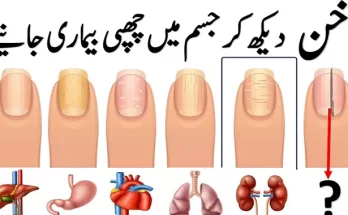
Nails are often seen as a mere adornment, a canvas for polish or art. However, beneath their aesthetic appeal lies a wealth of information about your overall health. From slight discoloration to changes in texture, your nails can serve as a window into your well-being. Understanding what your nails are trying to tell you can help detect underlying health issues early on. Here are nine things your nails can reveal about your health:
1. Color Changes:
Pay attention to any alterations in the color of your nails. A healthy nail typically sports a pinkish hue. If you notice discoloration such as yellowing, bluish tint, or white spots, it could indicate various health concerns. Yellow nails may signal fungal infection, while bluish nails might suggest poor circulation or oxygenation issues. White spots could be a sign of a nutrient deficiency, such as zinc or calcium.
2. Brittle or Fragile Nails:
Brittle nails that easily chip or break may point to nutritional deficiencies or dehydration. Insufficient intake of vitamins like biotin or minerals like iron can weaken nails. Additionally, frequent exposure to harsh chemicals, such as those found in cleaning agents or nail polish removers, can strip nails of their natural oils, making them brittle.
3. Spoon-shaped Nails:
If your nails appear scooped or concave, resembling a spoon, it might indicate anemia or iron deficiency. This condition, known as koilonychia, can also be associated with certain autoimmune disorders or thyroid problems. Consult a healthcare professional if you notice this peculiar shape in your nails.
4. Clubbing:
Clubbing refers to the enlargement of fingertips and nails, causing them to curve around the fingertips. This could be a sign of underlying cardiovascular or respiratory issues, such as lung disease or heart conditions. If you observe clubbing along with swelling and discoloration of the fingertips, seek medical advice promptly.
5. Pitting:
Small depressions or pits on the surface of your nails could be indicative of psoriasis, a chronic autoimmune disease affecting the skin. Psoriasis can also cause other nail abnormalities, such as ridges or thickening. If you suspect psoriasis or notice persistent pitting, consult a dermatologist for proper diagnosis and management.
6. Nail Thickening:
Thickened nails, particularly accompanied by yellowing or crumbling, maybe a symptom of fungal infection. Fungal nail infections, known as onychomycosis, thrive in warm, moist environments and can affect both fingernails and toenails. Prompt treatment is essential to prevent further spread and complications.
7. Beau’s Lines:
Beau’s lines are horizontal ridges or grooves that traverse the width of the nail. These lines can indicate periods of interrupted nail growth, often associated with severe illness, high fever, or trauma. By examining the depth and location of Beau’s lines, healthcare professionals can sometimes identify the timing and severity of past health events.
8. Nail Clubbing:
Nail clubbing refers to the bulbous enlargement of fingertips and nails, often accompanied by a curving downward of the nail. This condition is commonly associated with respiratory or cardiovascular disorders, such as chronic obstructive pulmonary disease (COPD) or congenital heart defects. Nail clubbing can develop gradually over time and may warrant further medical evaluation.
9. Yellowing or Thickening:
Yellowing and thickening of nails, particularly toenails, can be a common sign of fungal infection. However, it can also indicate more serious underlying conditions such as diabetes or thyroid disease. If you notice persistent yellowing or thickening of your nails, it’s advisable to consult a healthcare professional for proper diagnosis and treatment.
FAQs About Nail Health:
1. Can stress affect my nails?
Answer: Yes, stress can harm your nails. When stressed, you might bite or pick at your nails, making them weaker. Also, stress weakens your immune system, making it easier to get infections like fungal nail infections. Doing things to relax, like deep breathing or yoga, can help keep your nails healthier.
2. Are there natural ways to make my nails healthier?
Answer: Yes, you can use natural methods to improve your nail health. Massaging your nails and cuticles with oils like coconut or jojoba oil can strengthen and hydrate them. Eating a balanced diet with lots of vitamins and minerals, like biotin found in eggs and nuts, can also help.
3. Are acrylic or gel nails bad for my real nails?
Answer: Yes, using acrylic or gel nails too much can harm your natural nails. Putting them on and taking them off can strip your nails of their natural oils, making them weak and prone to fungal infections. It’s good to take breaks between applications and remove them carefully.
4. Does what I eat affect my nails?
Answer: Yes, eating a healthy diet is important for strong nails. Foods with protein, vitamins, and minerals help nails grow strong. Biotin, found in foods like eggs and nuts, is especially good for nails. But remember, nail problems can be caused by other things too, not just diet.
5. Does smoking make my nails look bad?
Answer: Yes, smoking can make your nails look and feel bad. The chemicals in cigarettes can make your nails weaker and slower to grow. It can also give your nails a pale or bluish color. Quitting smoking can help your nails look better and be healthier.
Your nails can tell you a lot about your health. If you notice any changes in their color, texture, or shape, it might be a sign of a health problem. But not all changes mean something serious, they could just be normal. Still, if you’re worried about changes in your nails, it’s a good idea to talk to a doctor. Healthy nails usually mean a healthy body.






